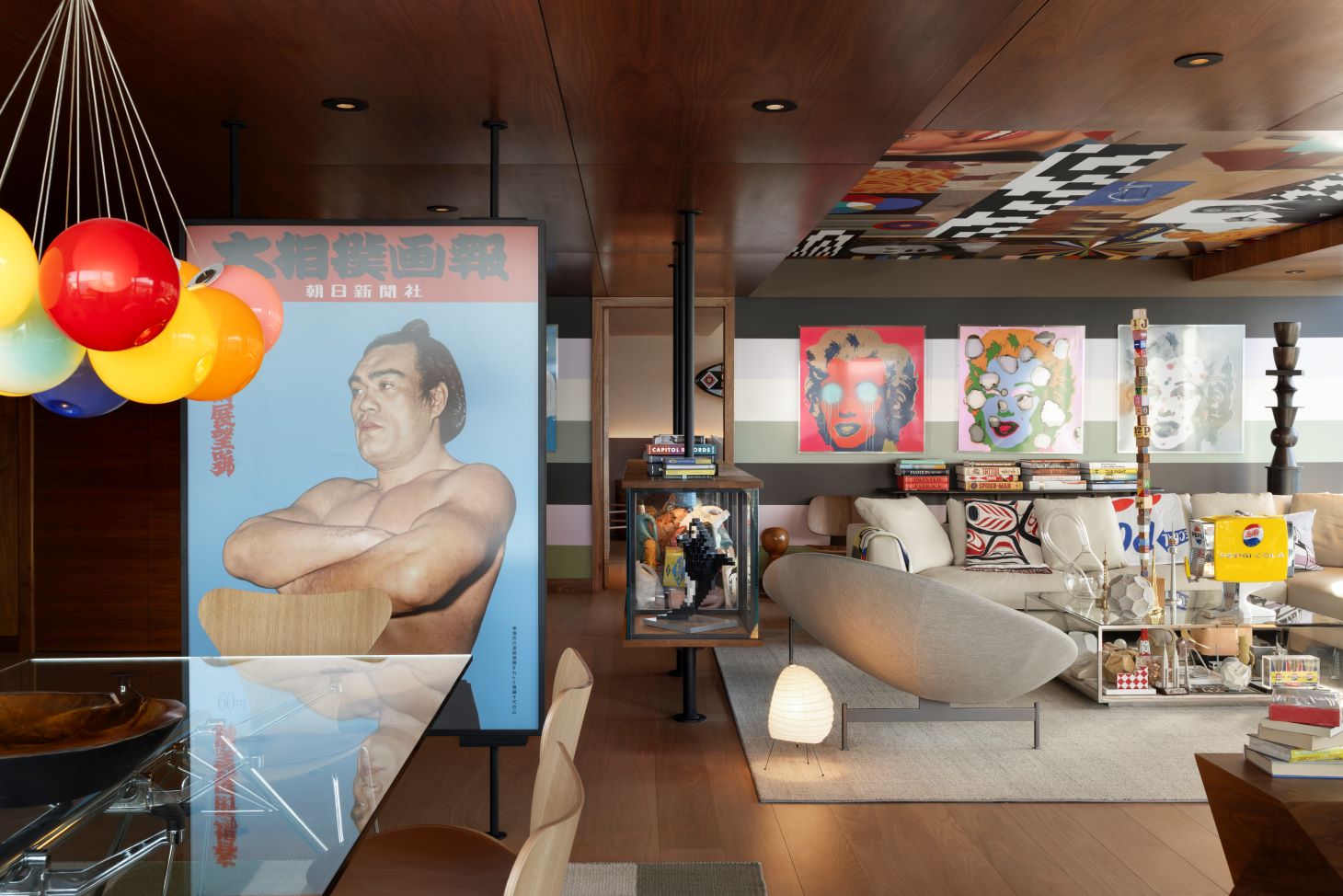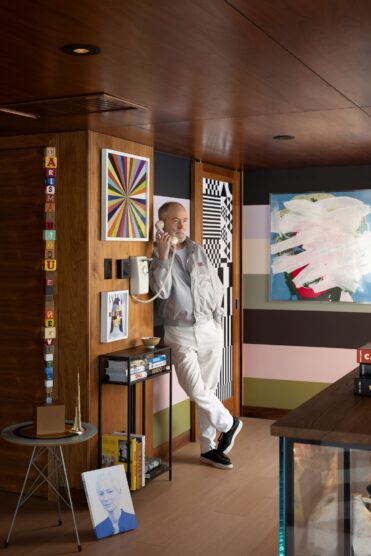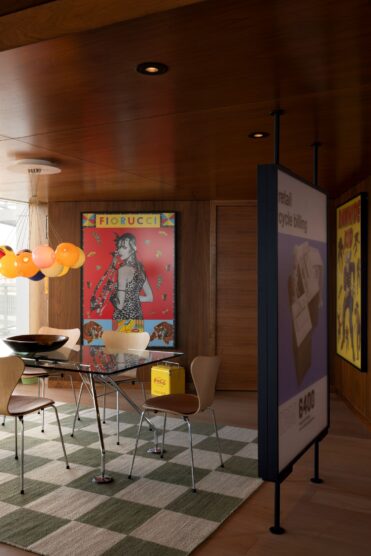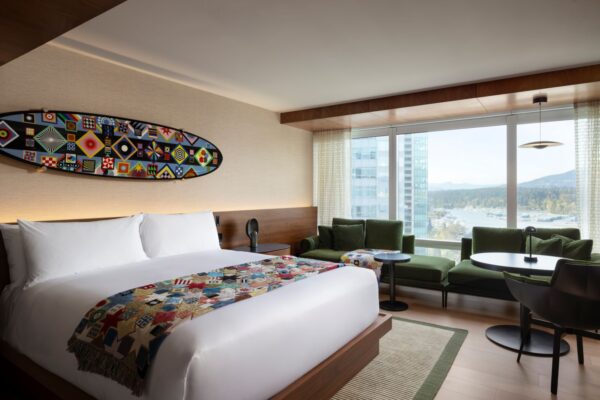Where Pop Art Meets Penthouse
Inside Suite X by Douglas Coupland at Vancouver’s Fairmont Pacific Rim.

Most luxury hotel suites follow a familiar script: neutral palettes, upscale materials, and a sense of global sameness. On the Fairmont Pacific Rim’s Gold Floor, the newly unveiled Suite X does something else entirely. Created by Canadian artist and author Douglas Coupland, it’s less a hotel suite than a conceptual installation with room service.
Part kaleidoscopic living space, part curated art display, Suite X functions as both a guest room and a personal statement. It reflects Coupland’s long-standing interest in the overlap of design, culture, and memory—rooted in his connection to Vancouver and shaped by decades of travel.
“I lived in hotels for 35 years,” says the artist whose debut novel, Generation X: Tales for an Accelerated Culture, popularized post-boomer disaffection with irony and wit. “So many hotel rooms, even super good ones, are just soul-crushingly generic. Suite X is a reaction to that—a rebuttal.”


The suite opens into a room that feels more like an artist’s studio than a hotel suite, filled with carefully placed objects, colours, and references. Pale wood floors are offset by modular furniture in red, yellow, and cobalt blue. A rotary phone sits on a shelf beside resin sculptures, art books, and personal ephemera. Nearly every item—furniture, decor, and artwork—was selected or created by Coupland himself.
A small model of Digital Orca—Coupland’s sculpture that stands just outside the hotel—sits on a shelf in the suite. It’s a quiet nod to the view outside, and a reminder of how closely his work is tied to the city. Nearby, a glass case holds pieces of marine debris that Coupland collected from Haida Gwaii after the 2011 Japanese tsunami. Some are rusted or weathered. Others have been sealed in resin or coated in metallic finishes. “Suite X is largely about marine ecology, as is much of my work,” he says. “Nobody puts a vitrine full of toxic marine debris in a hotel room without meaning something by it.”
The suite blends polished design details with salvaged or improvised elements. High-end art books and minimalist shelving sit alongside found objects from the shoreline. Some pieces feel temporary or disposable, others more archival—like items that could have come from Coupland’s own living room.

Despite its conceptual framing, Suite X still functions as a premium hotel room. The marble-accented bathroom includes heated floors, a soaking tub, Le Labo toiletries, and a Japanese Toto washlet. A walk-in closet offers generous storage and thick robes. Guests control lighting, curtains, and temperature through touchscreen panels, and an in-room digital concierge connects them with hotel services and local experiences.
What’s most unusual is how personal the space feels, despite being part of a luxury hotel brand. “Friends who visit the suite always say, ‘It looks just like your house!’ And it does,” Coupland says. The room reflects his sensibility as much as it captures a version of Vancouver that’s personal rather than promotional, rooted in experience rather than surface-level references.
Coupland hints that the suite will continue to evolve. One possible addition: a set of vintage 1970s Kraft Jet-Puffed marshmallow sleeping bags, sewn shut and reimagined as soft furnishings. “Humour is essential for storytelling,” he says. “At least until AI gets a sense of humour—which may be the one thing it will never understand, so we’re safe, at least for a while.”

That mix of dry humour, pop culture, and quiet discomfort runs through much of Coupland’s work—and Suite X is no exception. The view includes Canada Place, the harbour, and the North Shore mountains: a textbook Vancouver postcard. But it’s the interior that tells the deeper story.
Suite X doesn’t rely on skyline imagery or stylized references to establish a sense of place. Instead, it offers a more layered portrait of Vancouver, assembled from personal artifacts, collected debris, and reinterpreted history. Coupland, who once described growing up here as like living in “nowhere,” traces the city’s evolution into “somewhere,” especially after the 2010 Winter Olympics.
The suite’s contents form a loose autobiography, reflecting Coupland’s relationship with the city as much as the city’s shifting self-image. “The suite is unabashedly about me and my upbringing here,” he says. “But I’d like to think that guests would see items and ideas in the room and think of Vancouver as more than a beautiful face.”

It’s also a reflection of Fairmont’s willingness to explore how a hotel room might contribute to a broader cultural conversation: part hospitality, part storytelling.
Guests staying on the Gold Floor enjoy a range of perks: private check-in, an exclusive lounge with complimentary breakfast and evening snacks, garment pressing, high-speed Wi-Fi, and access to the pool and spa. But Suite X offers something else entirely: a stay that feels more like stepping into an artist’s process than a typical luxury suite.
Coupland didn’t just design the room—he used it to push back against the idea of what a hotel suite should be. When asked what he hopes guests feel when they walk through the door, his answer is simple: “That you’re entering a space that doesn’t exist anywhere else.”
Photographs by Ema Peter. Courtesy of Fairmont Pacific Rim.




